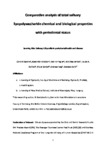Comparative analysis of total salivary lipopolysaccharide chemical and biological properties with periodontal status

Date
2020-02Author
Subject
Metadata
Show full item recordAbstract
OBJECTIVE: Clinical manifestations of Gram-negative bacteria mediated diseases can be influenced by how the host senses their major microbe-associated molecular pattern, the cell wall lipopolysaccharide (LPS). Keystone periodontal pathogens can produce a heterogeneous population of LPS molecules, with strikingly different host-microbiome interactions and immune outcomes. DESIGN: Structure-function correlations of salivary LPS extracts in patients with periodontitis before and after periodontal treatment and healthy volunteers were analysed by comparing its lipid A and carbohydrate chain chemical structure and evaluating its endotoxin activity and inflammatory potential. RESULTS: Salivary LPS extracts from periodontitis patients were characterised by high m/z lipid A mass-spectrometry peaks, corresponding to over-acylated and phosphorylated lipid A ions and by a combination of rough and smooth LPS carbohydrate moieties. In contrast, gingival health was defined by the predominance of low m/z lipid A peaks, consistent with under-acylated and hypo-phosphorylated lipid A molecular signatures, with long and intermediate carbohydrate chains as determined by silver staining. Total, diseased salivary LPS extracts were stronger inducers of the recombinant factor C assay and triggered significantly higher levels of TNF-α, IL-8 and IP-10 production in THP-1 cells, compared to almost immunosilent healthy samples. Interestingly, salivary LPS architecture, endotoxin activity, and inflammatory potential were well conserved after periodontal therapy and showed similarities to diseased samples. CONCLUSIONS: This study sheds new light on molecular pathogenic mechanisms of oral dysbiotic communities and indicates that the regulation of LPS chemical structure is an important mechanism that drives oral bacteria-host immune system interactions into either a symbiotic or pathogenic relationship.
Collections
Publisher
Place of Publication
Journal
Volume
Pagination
Number
Recommended, similar items
The following license files are associated with this item:

